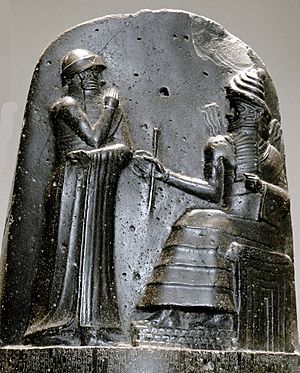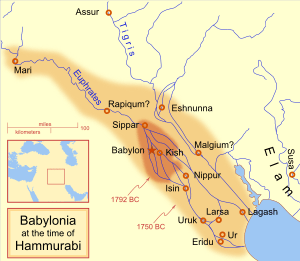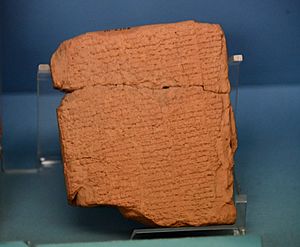Hammurabi facts for kids
Quick facts for kids Hammurabi𒄩𒄠𒈬𒊏𒁉 |
|
|---|---|
| King of Babylon King of the Four Corners of the World |
|

Hammurabi (standing), depicted as receiving his royal insignia from Shamash (or possibly Marduk). Hammurabi holds his hands over his mouth as a sign of prayer (relief on the upper part of the stele of Hammurabi's code of laws).
|
|
| King of the Old Babylonian Empire | |
| Reign | 42 years; c. 1792 – c. 1750 BC (middle) |
| Predecessor | Sin-Muballit |
| Successor | Samsu-iluna |
| Born | c. 1810 BC Babylon |
| Died | c. 1750 BC middle chronology (modern-day Iraq) (aged c. 60) Babylon |
| Issue | Samsu-iluna |
Hammurabi (Akkadian from Amorite ˤAmmurāpi, meaning "the kinsman is a healer," from ˤAmmu, meaning "paternal kinsman", and Rāpi, meaning "healer"), was the sixth king of Babylon from 1792 BC to 1750 BC. He became king after his father abdicated, and was the first ruler of Babylonia. By winning wars against other kingdoms in Mesopotamia, Hammurabi created a large Babylonian empire. However, his son Samsu-iluna and later Babylonian rulers lost much of the land he had gained.
Hammurabi is most famous for his laws, which are known as the Hammurabi's Code. Hammurabi's Code was one of the first written codes of law in history.
Contents
History
Hammurabi became king of Babylon in around 1792 BC, when his father Sin-Muballit abdicated. Babylon was one of many small independent cities in ancient Mesopotamia. These cities often fought each other for control of land. Babylon was already one of the more powerful cities when Hammurabi became king. Earlier kings of Babylon had taken over the nearby city-states of Borsippa, Kish, and Sippar.
Hammurabi did not fight any important wars in the early part of his reign. He instead improved the buildings of Babylon. He built taller city walls to make the city more difficult to attack, and expanded the temples. In around 1771 BC, the kingdom of Elam attacked Mesopotamia from the east. Elam invaded Eshnunna, a city-state to the north-east of Babylon, and destroyed its cities. It also tried to start a war between Babylon and Larsa, a city in southern Mesopotamia. However, Hammurabi instead made an alliance with Larsa against Elam. Hammurabi defeated Elam, but felt that Larsa had not given him enough help. He therefore attacked Larsa. Babylon had entirely conquered southern Mesopotamia by c. 1763 BC.
Hammurabi's allies in northern Mesopotamia had sent their armies to the south to help Babylon. This caused unrest in the northern area. Hammurabi therefore returned north, stopping the unrest, and defeating Eshnunna. He then attacked and conquered the remaining cities in northern Mesopotamia, including Babylon's former ally Mari. It is possible that Mari surrendered to Babylon without any fighting happening. After this, Hammurabi was in control of most of Mesopotamia. Only Aleppo and Qatna, two western cities in modern Syria remained independent. When Hammurabi died in c. 1750 BC, his son Samsu-iluna became king.
Code of laws
Hammurabi is best known for having issued the Code of Hammurabi, which he claimed to have received from Shamash, the Babylonian god of justice. Unlike earlier Sumerian law codes, such as the Code of Ur-Nammu, which had focused on compensating the victim of the crime, the Law of Hammurabi was one of the first law codes to place greater emphasis on the physical punishment of the perpetrator. It prescribed specific penalties for each crime and is among the first codes to establish the presumption of innocence. They were intended to limit what a wronged person was permitted to do in retribution. The Code of Hammurabi and the Law of Moses in the Torah contain numerous similarities.
The Code of Hammurabi was inscribed on a stele and placed in a public place so that all could see it, although it is thought that few were literate. The stele was later plundered by the Elamites and removed to their capital, Susa; it was rediscovered there in 1901 in Iran and is now in the Louvre Museum in Paris.
The code of Hammurabi contains 282 laws, written by scribes on 12 tablets. Unlike earlier laws, it was written in Akkadian, the daily language of Babylon, and could therefore be read by any literate person in the city. At this time, Akkadian replaced Sumerian, and Hammurabi began language reforms that would make Akkadian the most common language at this time.
Because of Hammurabi's reputation as a lawgiver, his depiction can be found in law buildings throughout the world. Hammurabi is one of the 23 lawgivers depicted in marble bas-reliefs in the chamber of the U.S. House of Representatives in the United States Capitol. A frieze by Adolph Weinman depicting the "great lawgivers of history", including Hammurabi, is on the south wall of the U.S. Supreme Court building.
Legacy
Hammurabi was seen by many as a god within his own lifetime. After his death, Hammurabi was revered as a great conqueror who spread civilization and forced all peoples to pay obeisance to Marduk, the national god of the Babylonians. Later, his military accomplishments became de-emphasized and his role as the ideal lawgiver became the primary aspect of his legacy. For later Mesopotamians, Hammurabi's reign became the frame of reference for all events occurring in the distant past. Even after the empire he built collapsed, he was still revered as a model ruler, and many kings across the Near East claimed him as an ancestor. Hammurabi was rediscovered by archaeologists in the late nineteenth century and has since been seen as an important figure in the history of law.
| Preceded by Sin-muballit |
Kings of Babylon |
Succeeded by Samsu-Iluna |
Images for kids
-
Code of Hammurabi stele. Louvre Museum, Paris
See also
 In Spanish: Hammurabi para niños
In Spanish: Hammurabi para niños






